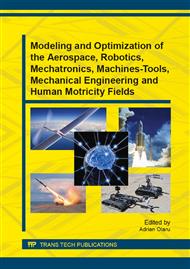[1]
Riley P. et al., Image fusion technology for security and surveillance applications, Optics and Photonics for Counterterrorism and Crime Fighting II, Lewis, C. & Owen, G.P. (Eds. ), Vol. SPIE-6402, pp.640204-640204, The International Society for Optical Engineering, Bellingham, WA, (2006).
DOI: 10.1117/12.689925
Google Scholar
[2]
Zou X. et al., Tracking humans using multi-modal fusion, 2nd Joint IEEE International Workshop on Object Tracking and Classification in and Beyond the Visible Spectrum (OTCBVS'05), pp. W01-30-1-W01-30-8, IEEE Press, Washington, USA, (2005).
DOI: 10.1109/cvpr.2007.382939
Google Scholar
[3]
O'Brien M.A. et al., Information fusion for feature extraction and the development of geospatial information, Proceedings of the 7th International Conference on Information Fusion (FUSION 2004), pp.976-982, International Society of Information Fusion, Mountain View, CA., (2004).
DOI: 10.1109/icif.2005.1591817
Google Scholar
[4]
Kong S.G. et al., Multiscale Fusion of Visible and Thermal IR Images for Illumination- Invariant Face Recognition, International Journal of Computer Vision, Vol. 71, No. 2, 215-233, (2007).
DOI: 10.1007/s11263-006-6655-0
Google Scholar
[5]
Toet A., Cognitive image fusion and assessment, TNO Human Factors, (2011).
Google Scholar
[6]
Petrovic V., Subjective tests for image fusion evaluation and objective metric validation, Information Fusion, Vol. 8, No. 2, pp.208-216, ISSN 1566-2535 (2007).
DOI: 10.1016/j.inffus.2005.05.001
Google Scholar
[7]
Zin T.T. e al., Fusion of infrared and visible images for robust person detection, Image Fusion, INTECH, (2011).
Google Scholar
[8]
Dixon T.D., et al., Methods for the assessment of fused images, ACM Transactions on applied Perception, vol. 3, no. 3, pp.309-332, (2006).
Google Scholar
[9]
Chen H., A perceptual quality metric for image fusion based on regional information, Proceedings of the SPIE: Multisenzor, Multisource Information Fusion: Architectures, Algorithms and Applications, vol. 5813, pp.24-45, (2005).
DOI: 10.1117/12.605784
Google Scholar
[10]
Xue Z., Concealed weapon detection using color image fusion, Electrical and Computer Engineering Department, Lehigh University, Bethlehem, PA, U.S. A, ISIF, (2003).
Google Scholar
[11]
Ulman S., Object recognition and segmentation by a fragment-based hierarchy, Trends in Cognitive Sciences, Vol. 11, No. 2, 58-64, (2007).
DOI: 10.1016/j.tics.2006.11.009
Google Scholar
[12]
Wani V. et al., A comparative study of image fusion technique based on feature using transforms functions, International Journal of Emerging Technology and Advanced Engineering, Volume 3, Issue 11, November, (2013).
Google Scholar


